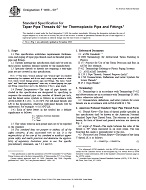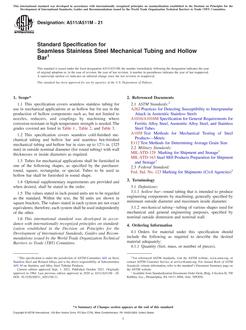1.1 This engine oil test method covers the evaluation of automotive engine oils (SAE grades 5W 10W, 20, 30, 40, and 50, and multiviscosity grades) intended for use in either spark-ignition gasoline engines, or in diesel engines. The test procedure is conducted using a carbureted, spark-ignition Cooperative Lubrication Research (CLR) Oil Test Engine (referred to as the L-38 engine in this test method). An oil is evaluated for protection against engine and oil deterioration under high-temperature, heavy-duty service conditions. The test method can also be used to evaluate the viscosity stability of multiviscosity-graded oils.
1.2 The two measures of engine deterioration used in this test method are (1) weight loss of copper-lead bearings used in the test power section, and (2) varnish and sludge deposits on power section parts.
1.3 The two measures of oil deterioration used in this test method are (1) the change in the acid number of the oil, and (2) the change in the viscosity of the oil during the test period.
1.4 Correlation of test results with those obtained in automotive service has not been established. Furthermore, the results obtained in this test method are not necessarily indicative of results that will be obtained in a full-scale automotive spark-ignition or compression-ignition engine, or in an engine operated under conditions different from those of the test method. The test can be used to compare one oil with another.
Note 1 – Companion test methods used to evaluate engine oil performance for specification requirements include the following current versions of single-cylinder and multicylinder engine tests:
ASTM STP 509A, Single Cylinder Engine Tests for Evaluating the Performance of Crankcase Lubricants Part I, Caterpillar 1G2 Test Method
Part II, Caterpillar 1H2 Test Method
ASTM STP 315H, Multicylinder Test Sequences for Evaluating Engine Oils
Part 1, Sequence IID
Part 2, Sequence IIID
Part 3, Sequence V-D
ASTM Research Report RR:D02-1225 Sequence IIIE, Multicylinder Test Sequence for Evaluating Automotive Engine Oils
ASTM D02 Proposal P212, Proposed Test Method for VE Test Procedure
Also, see Engine Oil Tests – SAE J304 for details on these and other engine oil test methods.
1.5 The values stated in inch-pound units are to be regarded as the standard; except for the case of bearing weight measurements, for which the unit is milligram; and except for viscosity measurements, for which the temperatures of measurement are expressed in C (degrees Celsius). SI values are given in parentheses. In cases where materials, products, or equipment are available only in inch-pound units, SI units are omitted.
1.6 This standard does not purport to address all of the safety concerns, if any, associated with its use. It is the responsibility of the user of this standard to establish appropriate safety and health practices and determine the applicability of regulatory limitations prior to use.
1.7 This test method is arranged as follows:
| Section | |
| Introduction | |
| Scope | 1 |
| Referenced Documents | 2 |
| Terminology | 3 |
| Summary of Test Method | 4 |
| Significance and Use | 5 |
| Apparatus | 6 |
| Test Engineering, Inc. | 6.1 |
| Fabricated or Specially Prepared Items | 6.2 |
| Instruments and Controls | 6.3 |
| Procurement of Parts | 6.4 |
| Reagents and Materials | 7 |
| Test Oil Sample Requirements | 8 |
| Preparation of Apparatus | 9 |
| Test Stand Preparation | 9.1 |
| Conditioning Test Run on Power Section | 9.2 |
| General Power Section Rebuild Instructions | 9.3 |
| Reconditioning of Power Section After Each Test | 9.4 |
| Calibration | 10 |
| Power Section and Test Stand Calibration | 10.1 |
| Instrumentation Calibration | 10.2 |
| Engine Operating Procedure | 11 |
| Run-In and Flush | 11.1 |
| Intermediate Bearing Weight Loss Checks | 11.2 |
| Test Operating Conditions | 11.3 |
| Warm-up Schedule | 11.4 |
| Air-Fuel Ratio and Spark Advance | 11.5 |
| Rocker Cover Air, Off-gas, and Blowby Measurement | 11.6 |
| Shut-down and Oil-Drain Procedure | 11.7 |
| Oil Sampling and Oil Addition | 11.8 |
| Oil Consumption Computation | 11.9 |
| Periodic Measurements | 11.10 |
| Determination of Test Results | 12 |
| Report | 13 |
| Precision and Bias | 14 |
| Use of ASTM Rounding | 15 |
| Keywords | 16 |
| Annexes | |
| Specification for Soltrol 107, 8 | Annex A1 |
| Measurement of Connecting Rod Bearing Clearance and Journal Taper | Annex A2 |
| Measurement of Main Bearing Clearance | Annex A3 |
| The ASTM Test Monitoring Center Calibration Program | Annex A4 |
| Data Log Sheets | Annex A5 |
| Measurement of Piston-to-Sleeve Clearance | Annex A6 |
| Control Chart Technique for a Laboratory’s Severity Adjustment (SA) | Annex A7 |
| Recommended New Liner Honing Procedure | Annex A8 |
| L-38 Oil Priming Procedure | Annex A9 |
| Alternative Crankcase Breather Configurations | Annex A10 |
| Connecting Rod Bearing Cleaning Procedure | Annex A11 |
| L-38 Electronic Ignition Conversion Procedure | Annex A12 |
| System Response Procedure | Annex A13 |
| Air-Fuel Ratio Measurement | Annex A14 |
| L-38 Engine Evaluation Report Forms | Annex A15 |
| Data Dictionary | Annex A16 |
| Stripped Viscosity Measurement Procedure | Annex A17 |
| Role of the ASTM Test Monitoring Center and the Calibration Program | Appendix X1 |
| Suggested Method for Salvaging Camshaft Bearing Journals | Appendix X2 |
Product Details
- Published:
- 06/10/2002
- Number of Pages:
- 56
- File Size:
- 1 file , 3.2 MB


